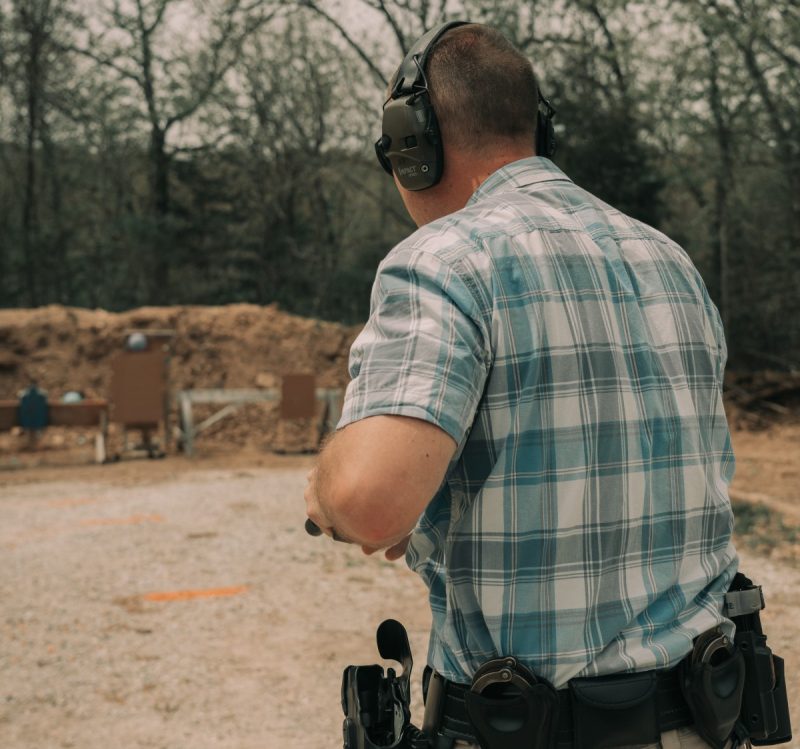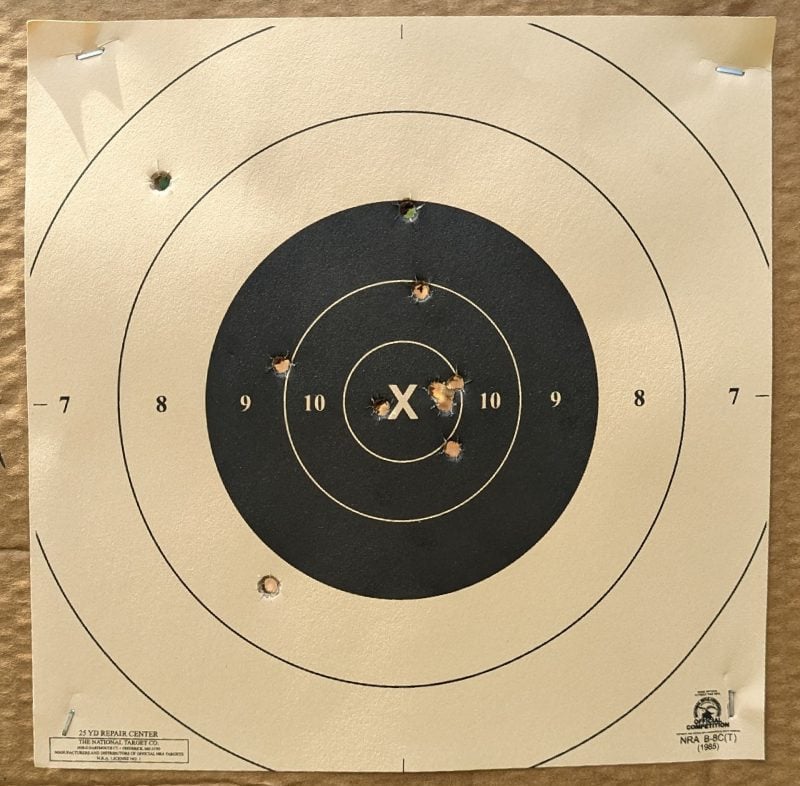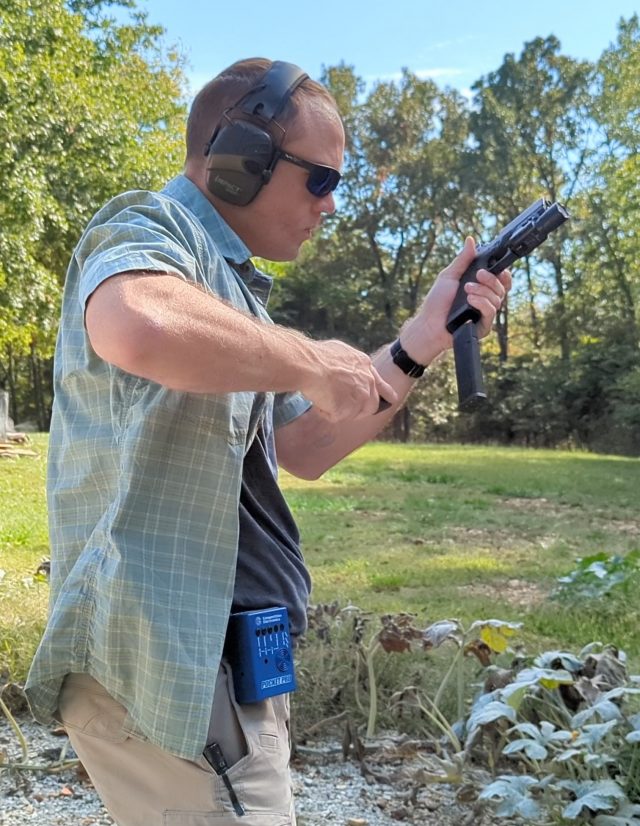Since I was a kid, the range was always a source of excitement. In past years, I made trips to the local shooting range for practice. Now, I’m spoiled with one in my backyard. As I added targets for practice and training, I finally decided to add a long overdue tool to my training toolbox — a shot timer. My excitement over this purchase was like being a kid at the range again. The shot timer has proven invaluable over the last year. If you’ve kept up with past articles, this tool was a regular part of performance evaluation. Furthermore, it has been worth its weight in gold in measuring performance and improvement.
Benefits – and Drawbacks – of a Shot Timer
The shot timer is a greater metric for evaluating shooting performance. All of us can shoot fast, but can we all shoot accurately? The five drills discussed below weigh accuracy against speed differently. Just as in the real world, accuracy may have greater importance than speed under certain circumstances. Hostages, body armor, and crowded areas necessitate precision shooting. Conversely, close-quarter engagements may require less focus on precision, but greater emphasis on rapid engagement.
The primary word of caution when using a shot timer is not to focus on how “fast” you are. Rather, attend to how quickly you competently complete a drill with accurate hits on target. To take things a step further, use your time as a basis to evaluate progress. If you’re not progressing in a drill, there’s a reason. By evaluating shot placement and the times to accomplish a drill, you can direct attention to where training and skills need improvement. Here are five drills utilizing a shot timer that evaluate performance, build skills, and identify areas of improvement.
Five Drills with a Shot Timer
9-in-9
Course of Fire
Rounds: 9
Target: 3″ x 5″ notecard
Distance: 5 yards (two shooting positions 5 yards apart and offset from target)
Par Time: 12 seconds
The 9-in-9 drill is the brainchild of Dave Spaulding of Handgun Combatives. Spaulding is a wealth of knowledge and a great asset to the firearms community. While I applaud him on his recent retirement, I selfishly missed the opportunity to attend one of his courses. Nevertheless, Spaulding has published many of his drills online and on his YouTube channel (@handguncombatives). Among those drills, the “9-in-9” caught my eye and quickly became a favorite.

9-in-9 is a relatively simple course of fire. The firing line is five yards from the target. The shooting positions and target make a triangle with the two shooting positions offset from the target with five yards between them. The shooter starts at the first shooting position and, upon the shot timer beep, draws and fires three rounds onto a 3″ x 5″ notecard. The shooter sprints to the second position, re-engages the notecard with three more rounds, and returns to the starting position to fire the final string of three rounds. The par time is 12 seconds but, to paraphrase Spaulding, “get to nine seconds and you need to find something else to be good at”. If you miss the notecard, you fail the drill.
The precision required by the small target (a cost-effective analog for the size of the human heart) and time constraints make this drill challenging. The drill seamlessly integrates movement, sight acquisition, muzzle and trigger discipline, proper recoil management, and precision speed shooting. Every time I’ve introduced someone to this drill, they immediately want to run it again.
Speed Draw Drill
Course of Fire
Rounds: 1-3
Target: B-27 or IPSC/USPSA
Distance: 5 – 15 yards
Par Time: None
This drill is exceptionally simple but can be as difficult or as easy as the shooter wants to make it. At first glance, this may seem like range theatrics, but it serves a far greater purpose than that by isolating draw mechanics and refining shooting technique. If done purposefully, the shooter learns when, and where, speed and efficiency play into making accurate shots in less time.

The drill is scalable to the shooter’s skill set. The simplest version is shot from five yards with one round. The shot timer has no par time. Your personal best is the par. At the start beep, the shooter draws and fires between one and three rounds. The goal is to isolate draw time to the first shot and, if firing follow-up shots, split times. Accordingly, score your target and balance the score and time between acceptable precision and speed as you repeat the drill. At greater distances, the par time from the start beep to the first shot should increase by around one second per 10 yards. This isn’t a speed competition. It’s an evaluation of draw speed efficiency, accuracy, and recoil management. Recording yourself shooting or including a knowledgeable range partner goes a long way in evaluating your performance in this drill too.
No Fail Pistol Drill
Course of Fire
Rounds: 10 strings of 1 round
Target: B-8 Bullseye Target
Distance: 25 yards
Par Time: 3.5 seconds per string
The “No Fail Pistol” drill is the brainchild of retired Army SGM Chuck Pressburg. SGM Pressburg came up with this drill as a test of true pistol competency. While an excellent measure of skill, some may find this drill maddening and somewhat sadistic. The shot timer is set with a 3.5-second par time. The shooter fires 10 strings of one round from the draw (concealment or duty retention). At least nine of the shots must be made within the par time. All 10 rounds must hit within the black of a B-8 target. This drill isn’t impossible, but incredibly difficult.

The B-8 target measures 10.5″ x 10.5″ while the black measures 5.5″ in diameter. This exceptionally small target challenges the shooter to make a precision headshot at a distance under a time constraint. While SGM Pressburg may have additional input as to its purpose, I see this drill as realistic in today’s age of active killers utilizing body armor. When armed with a pistol, a precision shot to the body’s nervous system is the best opportunity to stop the threat. Personally, I’ve never passed the drill, which is shot with no warm-up. I’ve come close and normally shoot seven to nine within the black. The drill can be adjusted with longer par times or a slightly different target. Ultimately, the goal is to work towards getting all 10 in the 5.5″ circle within the par time.
Downshift Drill
Course of Fire
Rounds: 2 – 6
Target: Shooter’s preference
Distance: 5 – 50 yards
Par Time: None
I’ve modified this borrowed drill to add a little more work for the shooter. Nevertheless, it can be as complex, or simple, as the shooter wants to make it. The shooter starts at the longest distance they can consistently engage a target of their choosing. I normally use B-27 or IPSC/USPSA targets. In this example, I start at 35 yards with a second target at five yards. Upon the shot timer beep, I draw and engage the target at five yards with two rounds and transition to the target at 35 yards with two additional rounds. You can include up to three targets and engage each with one or two rounds. The target order isn’t important as long as the targets change distances by at least 20 yards between them.

The drill’s goal is to teach the shooter when to speed up or slow down. Newer, less practiced, shooters tend to rush shots at longer distances. This drill encourages shooters to develop a feel for when they need to “downshift” their speed for precision or long-range shots. By changing the target’s order, a shooter can also learn to adjust when they need to speed up their shot engagement. There is no par time for this course of fire as you’re shooting against your personal best. The shot timer is there to determine your ideal speed and pace for maximum effectiveness.
Reload Competency Drill
Course of Fire
Rounds: 6
Target: Shooter’s preference
Distance: 7 yards
Par Time: None
There’s far more to being a competent shooter than just accurately shooting holes into paper as fast as possible. Skills like moving, decision-making, and proper weapon manipulation are critical parts of the greater “gunfighter package”. Firearms are mechanical devices and, like any mechanical device, they can malfunction. Furthermore, we don’t have an endless supply of ammunition in the gun. Spare ammunition is crucial in the event a magazine fails or we encounter a nightmare scenario straight out of a John Wick film.

The reload competency drill is malleable and, like many other drills I’ve listed, adjustable to your needs and deficiencies. This drill can include emergency or combat reloads — or a combination thereof. I shoot at seven yards with three targets downrange. I load magazines to capacity (combat reloads) or two rounds each. After the shot timer beeps, I engage the first target with two rounds, reload, two more rounds to the next target with a reload, and two rounds to the final target. Furthermore, I used the split times on the shot timer to assess how consistent the reloads were and establish my baseline. I use that baseline to work on reload mechanics and identify deficiencies. The primary focus is on reloading followed by properly re-acquiring sights for effective hits.
Reminders When Using a Shot Timer
The shot timer is a great tool for evaluating your skills. Furthermore, it’s great for measuring improvement — just as scoring the rings on a target is. However, the shot timer is not meant to encourage speed over accurate shot placement. Since I began using a shot timer, I’ve found it’s an excellent gauge for recording where the limits of my accuracy extend while isolating areas where I need to obtain “acceptable” speed with passing accuracy. So, if you don’t have a shot timer, go out and buy one. It’s a fantastic tool for measuring your improvement while having a little fun too.


